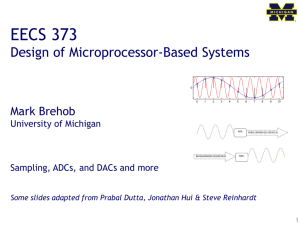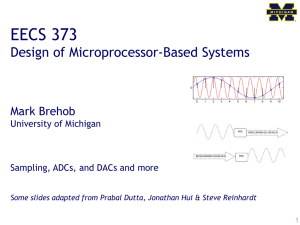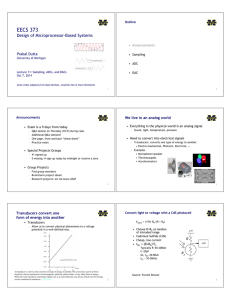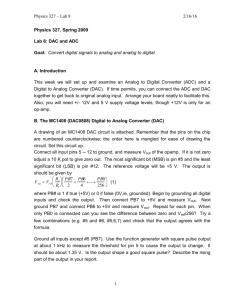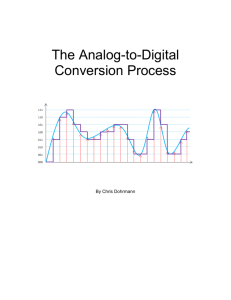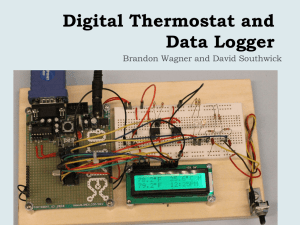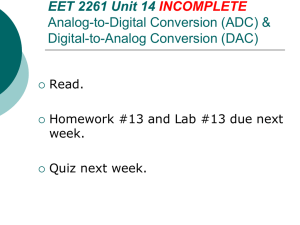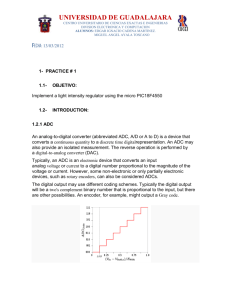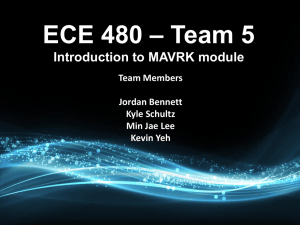1 - Electrical Engineering and Computer Science
advertisement
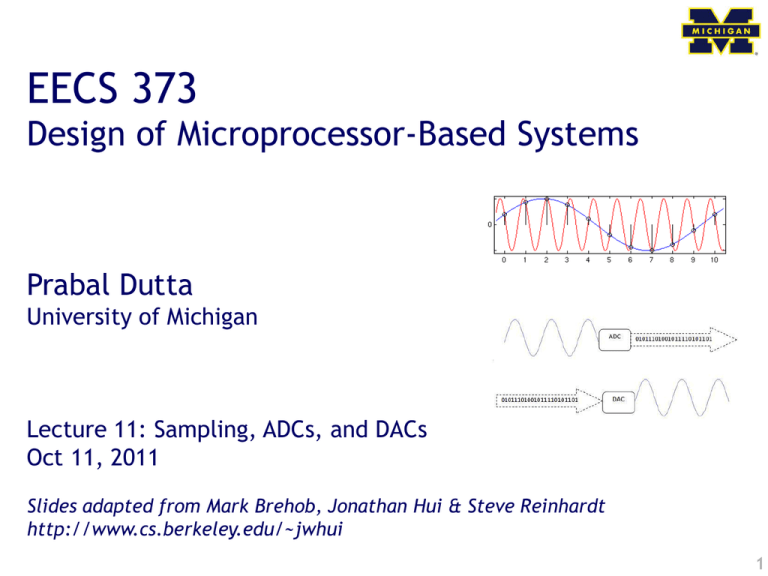
EECS 373 Design of Microprocessor-Based Systems Prabal Dutta University of Michigan Lecture 11: Sampling, ADCs, and DACs Oct 11, 2011 Slides adapted from Mark Brehob, Jonathan Hui & Steve Reinhardt http://www.cs.berkeley.edu/~jwhui 1 Announcements • HW2/practice midterm posted – Due Oct 19 at noon! – Slide under door in 4773 CSE – Come to Oct 13 class with questions 2 Midcourse Feedback • What are the GSI lab hours? – • Labs are in flux during the week – • Links, sample code, simple verilog-xl CAEN toolchain help posted Need some feedback on assembly language – • Labs 4 & 5 now have extended deadlines Verilog primer needed (or comment code) – • Range of skills some finish during lab; others take longer Hard to balance labs + homework/project – • HW#2 (and practice midterm) now posted. Due in 8 days. Labs are too long – • http://www.eecs.umich.edu/courses/eecs373/labs.html main site Unsure what will be on the midterm – • Done Lab websites not synchronized – • This is now being discussed; we’re looking for solutions More syllabus clarity needed – need lab placeholders – • Labs are still evolving; sometimes this takes longer than one would like GSI’s not communicating w/ each other about labs – • http://tinyurl.com/3lxyu4s Worked out sample code now posted Use a forum rather than email 3 Outline • Announcements • Sampling • DACs • ADCs & Errors 4 We live in an analog world • Everything in the physical world is an analog signal – Sound, light, temperature, pressure • Need to convert into electrical signals – Transducers: converts one type of energy to another • Electro-mechanical, Photonic, Electrical, … – Examples • Microphone/speaker • Thermocouples • Accelerometers 5 Transducers convert one form of energy into another • Transducers – Allow us to convert physical phenomena to a voltage potential in a well-defined way. A transducer is a device that converts one type of energy to another. The conversion can be to/from electrical, electro-mechanical, electromagnetic, photonic, photovoltaic, or any other form of energy. While the term transducer commonly implies use as a sensor/detector, any device which converts energy can be considered a transducer. – Wikipedia. 6 Convert light to voltage with a CdS photocell Vsignal = (+5V) RR/(R + RR) • Choose R=RR at median of intended range • Cadmium Sulfide (CdS) • Cheap, low current • tRC = Cl*(R+RR) – – – – Typically R~50-200kW C~20pF So, tRC~20-80uS fRC ~ 10-50kHz Source: Forrest Brewer 7 Many other common sensors (some digital) • Force – – – • Acceleration strain gauges - foil, conductive ink conductive rubber rheostatic fluids • Piezorestive (needs bridge) – – – Sonar – – – microswitches shaft encoders gyros Source: Forrest Brewer Motor current • Stall/velocity Temperature • Voltage/Current Source • Field – – Antenna Magnetic • Hall effect • Flux Gate • Usually Piezoelectric • Position Battery-level • voltage • Charge source • Both current and charge versions – – – Microphones MEMS Pendulum • Monitoring piezoelectric films capacitive force • Sound – – – • Location – – Permittivity Dielectric Going from analog to digital • What we want Physical Phenomena Engineering Units • How we have to get there Physical Phenomena Voltage or Current Sensor Engineering Units ADC Counts ADC Software 9 Representing an analog signal digitally • How do we represent an analog signal? – As a time series of discrete values On MCU: read the ADC data register periodically f ( x) Counts V f sampled ( x ) t TS 10 Choosing the horizontal range • What do the sample values represent? – Some fraction within the range of values What range to use? Vr Vr Vr Vr Range Too Small t Range Too Big t Vr Vr Ideal Range t 11 Choosing the horizontal granularity • Resolution – Number of discrete values that represent a range of analog values – MSP430: 12-bit ADC • 4096 values • Range / 4096 = Step Larger range less information • Quantization Error – How far off discrete value is from actual – ½ LSB Range / 8192 Larger range larger error 12 Converting between voltages, ADC counts, and engineering units • Converting: ADC counts Voltage Vr V in N ADC 4095 N ADC V in N ADC Vr t V in V R VR VR VR VR 4095 • Converting: Voltage Engineering Units V TEMP 0 . 00355 ( TEMP TEMP C C ) 0 . 986 V TEMP 0 . 986 0 . 00355 13 A note about sampling and arithmetic • Converting values in 16-bit MCUs V TEMP N ADC VR VR TEMP 4095 C V TEMP 0 . 986 0 . 00355 vtemp = adccount/4095 * 1.5; tempc = (vtemp-0.986)/0.00355; tempc = 0 • Fixed point operations – Need to worry about underflow and overflow • Floating point operations – They can be costly on the node 14 Choosing the sample rate • What sample rate do we need? – Too little: we can’t reconstruct the signal we care about – Too much: waste computation, energy, resources • Example: 2-bytes per sample, 4 kHz 8 kB / second f ( x) f sampled ( x ) t 15 Shannon-Nyquist sampling theorem • If a continuous-time signal f ( x ) contains no frequencies higher than f max , it can be completely determined by discrete samples taken at a rate: • Example: f samples 2 f max – Humans can process audio signals 20 Hz – 20 KHz – Audio CDs: sampled at 44.1 KHz 16 Use anti-aliasing filters on ADC inputs to ensure that Shannon-Nyquist is satisfied • Aliasing – Different frequencies are indistinguishable when they are sampled. • Condition the input signal using a low-pass filter – Removes high-frequency components – (a.k.a. anti-aliasing filter) 17 Designing the anti-aliasing filter • Note w is in radians w = 2pf • Exercise: Find an R+C pair so that the half-power point occurs at 30 Hz 18 Can use dithering to deal with quantization • Dithering – Quantization errors can result in large-scale patterns that don’t accurately describe the analog signal – Introduce random (white) noise to randomize the quantization error. Direct Samples Dithered Samples 19 Lots of other issues • Might need anti-imaging filter • Cost and power play a role • Might be able to avoid analog all together – Think PWM when dealing with motors… 20 Outline • Announcements • Sampling • DACs • ADCs 21 A decoder-based DAC architecture in linear and folded forms 22 A binary-scaled DAC architecture in linear and folded forms • Much more efficient • Monotonicity not guaranteed • May experiences glitches 23 DAC output signal conditioning • Often use a low-pass filter • May need a unity gain op amp for drive strength 26 Outline • Announcements • Sampling • DACs • ADCs 27 ADC #1: Flash Vref R R Vin priority encoder + _ 3 + _ 2 2 Dout R + _ 1 Vcc 0 R ADC #2: Single-Slope Integration Vin Vcc + _ I done C EN* n-bit counter CLK • Start: Reset counter, discharge C. • Charge C at fixed current I until Vc > Vin . How should C, I, n, and CLK be related? • Final counter value is Dout. • Conversion may take several milliseconds. • Good differential linearity. • Absolute linearity depends on precision of C, I, and clock. ADC #3: Successive Approximation (SAR) 1 Sample Multiple cycles • Requires N-cycles per sample where N is # of bits • Goes from MSB to LSB • Not good for high-speed ADCs Errors and ADCs • Figures and some text from: – Understanding analog to digital converter specifications. By Len Staller – http://www.embedded.com/showArticle.jhtml?articleID=60403334 • Key concept here is that the specification provides worst case values. Sometimes the intentional ½ LSB shift is included here! Differential non-liniearity DNL value given in a spec is the worst-case (Same with all the others…) Full-scale error is also sometimes called “gain error” full-scale error is the difference between the ideal code transition to the highest output code and the actual transition to the output code when the offset error is zero. The integral nonlinearity (INL) is the deviation of an ADC's transfer function from a straight line. This line is often a best-fit line among the points in the plot but can also be a line that connects the highest and lowest data points, or endpoints. INL is determined by measuring the voltage at which all code transitions occur and comparing them to the ideal. The difference between the ideal voltage levels at which code transitions occur and the actual voltage is the INL error, expressed in LSBs. INL error at any given point in an ADC's transfer function is the accumulation of all DNL errors of all previous (or lower) ADC codes, hence it's called integral nonlinearity. Questions? Comments? Discussion? 38
